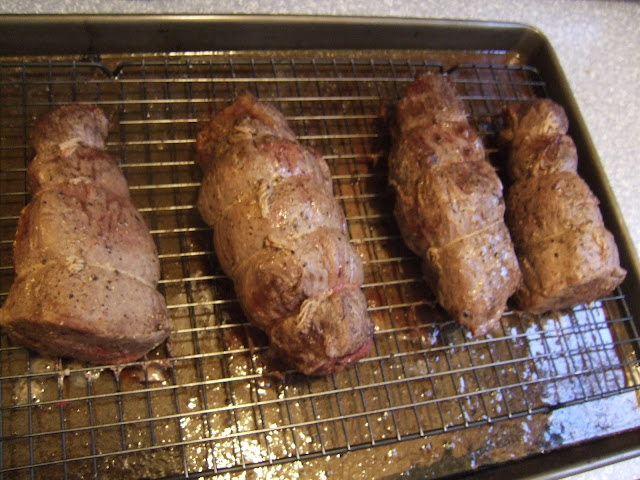 I don't usually cook with such upscale cuts like the tenderloin so this was a special occasion. This recipe is interesting because I seared the beef after it had roasted slowly in the oven, and I really think that cooks it the best. It also prevents there from being the ugly grey ring around the outside. I personally think this is best cooked medium rare, and no more. Because tenderloin is a relatively lean cut, it can dry out easily so be sure not to overcook it. I like to serve it with mashed potatoes, gravy and green beans. If you have time, a quick horseradish cream goes nicely with the beef as well.
I don't usually cook with such upscale cuts like the tenderloin so this was a special occasion. This recipe is interesting because I seared the beef after it had roasted slowly in the oven, and I really think that cooks it the best. It also prevents there from being the ugly grey ring around the outside. I personally think this is best cooked medium rare, and no more. Because tenderloin is a relatively lean cut, it can dry out easily so be sure not to overcook it. I like to serve it with mashed potatoes, gravy and green beans. If you have time, a quick horseradish cream goes nicely with the beef as well. Ingredients for Jus (fancy word for gravy)
1 onion
3 stalks celery
2 carrots
1 lb ground beef
3 tbsp tomato paste
2 bay leaves
3 cloves garlic
1 sprig rosemary and/or thyme
1 cup red wine
1 quart chicken broth
water, as needed
Ingredients for Roast Beef and Horseradish Cream
Beef Tenderloin (you can use as much as you want here. I think I had about 3 lbs?)
Salt, to taste
2 tbsp softened butter
Pepper, to taste
1 three inch piece fresh horseradish (more on this later)
2 tbsp apple cider vinegar
1 cup heavy whipping cream
1 tbsp vegetable oil
You only need to (very) roughly chop the onions, carrot, and celery. You should know by now that this is called a mirepoix and is the base flavor of almost any sort of braised or stewed dish in France.
Cook the ground beef over high heat, crumbling it up while you go.
When the beef is a bit browned and all the liquid has evaporated off, add the tomato paste and cook until you think the bottom of the pan is just about to burn.
The add the wine and reduce slightly. Make sure to scrape up the browned bits on the bottom of the pan.
Next add the broth, and enough water until it looks right. Throw in the rosemary, garlic, and bay leaves. Bring to a boil, reduce to a simmer, and cook for at least one hour, preferably more like three. Once the stock has finished simmering, strain it through a sieve and sprinkle the gelatin over the top. Stir to dissolve the gelatin, then reheat. The purpose of the gelatin is to mimic the collagen rich meat from veal bones that traditionally would be added to a demi-glace.
Meanwhile, I trimmed the beef of any silverskin and tied it up just to keep it in a fairly uniform shape.
Salt the meat, but don't add the pepper yet. Place the salted meat in the fridge for an hour before roasting. This will make the steak more moist after cooking.
While I was waiting on the beef, I peeled about a 3 inch piece of horseradish. This stuff is really spicy, but a different kind of spice than, say, a hot pepper.
I just use a knife to peel it, but you could certainly use a vegetable peeler.
Next, grate in on a micro-plane and transfer to a small bowl. You could do this in a food processor, but since I was only making a little bit I didn't want to go through all the hassle.
Mix the grated horseradish with the vinegar and a pinch of salt. Set aside until ready to use.
After the meat had been in the fridge for an hour with the salt on it, I patted it dry and sprinkled it generously with pepper. Then I rubbed it with the softened butter and place it on a wire rack set in a roasting pan. The butter adds some much needed fat to the lean tenderloin and also helps the meat brown in the oven.
Don't listen to those health maniacs; butter is perfectly good for you. Heat your oven to 300 degrees, and once heated, throw in the tenderloins.
Next whip the cream (you can do it by hand) until it holds peaks. Then stir in the horseradish and a pinch of salt and pepper. Set aside.
Horseradish is a classic accompaniment to beef.
This is what the meat looked like after 45 minutes in the 300 degree oven. You want an internal temperature of 125 degrees for medium rare
Next heat a tablespoon of oil in a pan until just smoking.
I seared the steaks two at a time, very briefly until the sides were well browned.
Then repeat with the other two filets. As will all meat, you want to let this rest under a tent of foil for 5-10 minutes before you cut into it.
All you have to do now is slice and serve, making sure to ladle some jus over the beef and the potatoes. I also steamed some green beans.
Enjoy!
















































